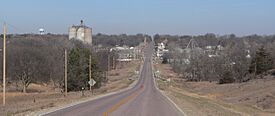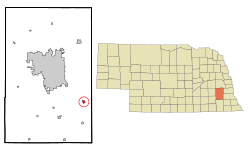Bennet, Nebraska facts for kids
Quick facts for kids
Bennet, Nebraska
|
|
|---|---|
|
Village
|
|

Bennet, seen from the south along Nebraska Highway 43
|
|

Location of Bennet, Nebraska
|
|
| Country | United States |
| State | Nebraska |
| County | Lancaster |
| Founded | July 29, 1871 |
| Incorporated | October 1, 1881 |
| Area | |
| • Total | 0.518 sq mi (1.343 km2) |
| • Land | 0.518 sq mi (1.343 km2) |
| • Water | 0.000 sq mi (0.000 km2) |
| Elevation | 1,299 ft (396 m) |
| Population
(2020)
|
|
| • Total | 1,082 |
| • Estimate
(2023)
|
1,080 |
| • Density | 2,083/sq mi (804.3/km2) |
| Time zone | UTC−6 (Central (CST)) |
| • Summer (DST) | UTC−5 (CDT) |
| ZIP Code |
68317
|
| Area code(s) | 402 and 531 |
| FIPS code | 31-04300 |
| GNIS feature ID | 2398094 |
| Sales tax | 6.5% |
Bennet is a small village located in Lancaster County, Nebraska, in the United States. It is part of the larger Lincoln metropolitan area. In 2020, about 1,082 people lived there.
Contents
History of Bennet, Nebraska
Bennet was founded on July 29, 1871. This happened when a railroad line, built by the Midland Pacific Railway, reached this spot. The village was built on land that used to belong to William Roggenkamp. It was a station for the new train line that connected Lincoln to Nebraska City.
The village was first called Bennett's Station. It was named after John Bennett, who was an officer of the Midland Pacific Railway. Bennet officially became an incorporated town on October 1, 1881. This meant it could have its own local government.
Bennet's Growth and Changes Over Time
In the early 1900s, Bennet became a busy place for business and social life in the area. At that time, the nearby city of Lincoln was still quite small.
Later, Bennet's population started to get smaller. Many local businesses closed. People moved to bigger cities to find work.
Today, Bennet is like many other small towns in Lancaster County. Lincoln has grown to be the main center for government, money, business, and culture in the county. However, Bennet has recently seen its population grow again. More people are choosing to live in Bennet, even if they work in Lincoln.
A survey in 1992 showed that 76% of Bennet's residents traveled to Lincoln for work. A more recent survey found that 44% of people moved to Bennet for its small-town feel. They liked the lower cost of living, cleaner air, and a good school system.
Geography of Bennet
Bennet is located in Nebraska. According to the United States Census Bureau, the village covers a total area of about 0.518 square miles (1.343 square kilometers). All of this area is land, meaning there are no large bodies of water within the village limits.
Population and People of Bennet
| Historical population | |||
|---|---|---|---|
| Census | Pop. | %± | |
| 1880 | 214 | — | |
| 1890 | 474 | 121.5% | |
| 1900 | 495 | 4.4% | |
| 1910 | 457 | −7.7% | |
| 1920 | 473 | 3.5% | |
| 1930 | 428 | −9.5% | |
| 1940 | 412 | −3.7% | |
| 1950 | 396 | −3.9% | |
| 1960 | 381 | −3.8% | |
| 1970 | 489 | 28.3% | |
| 1980 | 523 | 7.0% | |
| 1990 | 544 | 4.0% | |
| 2000 | 570 | 4.8% | |
| 2010 | 719 | 26.1% | |
| 2020 | 1,082 | 50.5% | |
| 2023 (est.) | 1,080 | 50.2% | |
| U.S. Decennial Census 2020 Census |
|||
Bennet's Population in 2020
In 2020, the census counted 1,082 people living in Bennet. There were 379 households and 287 families in the village. The village had 395 housing units.
The average number of people per household was about 2.51. The average family size was about 2.99 people.
Bennet's Population in 2010
According to the 2010 census, there were 719 people living in Bennet. There were 286 households and 199 families. The village had 306 housing units.
The median age in the village was 32.9 years. This means half the people were younger than 32.9 and half were older. About 26.6% of the residents were under 18 years old. About 11.5% were 65 years or older.
See also
 In Spanish: Bennet (Nebraska) para niños
In Spanish: Bennet (Nebraska) para niños

